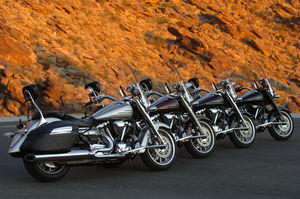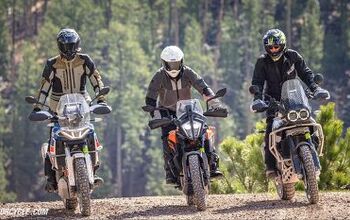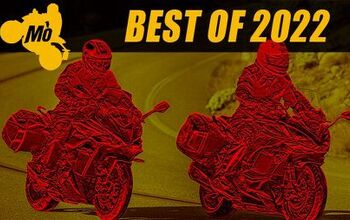Motorcycle.com

Highway 249 is a wild roller-coaster, going from 2,000 feet up to 6,500 feet in just 20 miles. The trip to the summit and down to the Coachella Valley below is a carnival ride packed with heartbreaking twists and turns, happily on smooth pavement that encourages aggressive riding.
This demanding stretch of pavement might not be the best place to ride a luxury touring cruiser, but Star Motorcycles, Yamaha's new cruiser brand, wanted to demonstrate the new bike's sporting prowess along with its luxury and touring features. How well did it work? To find out, I was sent to the money-scented town of Palm Springs, California, to take advantage of Yamaha's hospitality and the area's spectacular winding desert and mountain roads.
Why was Star having a separate press intro for this 700-pound touring cruiser, which looks like an accessorized Roadliner, a bike Star launched just a couple of months ago? And why would they put a touring barge like this on some of the swoopiest, twistiest bits of pavement in the area? To help explain, Star's Brad Bannister hosted a presentation to explain the differences between the touring cruiser buyer and the more traditional buyer.
He started by pointing out that touring cruiser riders, or "TCs," purchased enough motorcycles -- more than 75,000 last year industry wide -- to justify having a separate model and press intro to get the word out to this very different demographic.
Touring Cruiser riders are different from their Cruiser brethren because they ride their motorcycles more often, and for greater distances. In addition to being older and more experienced riders, Yamaha's research suggests that TCs also care more about practical aspects like passenger comfort, wind protection and luggage capacity. Sure, Kawasaki's low-tech Concours sport tourer will do it all for half the price, but TC buyers are not just practical-minded drudges; appearance, sound and performance are also crucial to these folks.
Styling is at the forefront of almost every aspect of the Stratoliner. Designed to remind us of vehicles and architectureof the 1930s and `40s, the bike is awash in swoopy, flowing, Art Moderne lines. Starting at the beautiful, sweeping headlight nacelle and ending with a stylishly tapered aluminum swingarm, there are lavish dollops of style everywhere on the big bike. For those of you think the chrome accents on the tank are too Iron Man, they are put on there with double-sided tape so you can take them off easily. Components like the triangular LED taillight and pointy turn signals accent and counterpoint the smooth, flowing lines from custom components like the brake and clutch master cylinders and chrome front fender supports.
Those of you who read our Roadliner intro story will find the tech briefing eerily familiar, as the two machines are essentially exactly the same mechanically. You can read more tech stuff in Managing Editor Pete Brissette's intro story, but here are some of the things Star felt were important to emphasize with this model.
Aside from a rear shock with more preload, a simple, easily removable package of touring accessories - windscreen, luggage and sissy bar - sets the Stratoliner apart from its Roadliner cousin. The ample windscreen is available in three sizes: 17", 21" and 24" high, although just the medium 21" screen comes standard. The 1430 cubic-inch, hard-case saddlebags are plastic and finished with nice, soft leather. The lids flip outwards and lock in the center. They mount onto their mounts with easy-to-use Dzus fasteners, but the industrial-looking black steel frame they are attached to stays on the bike; they don't come for looks, but rather to help you clean and maintain your Stratoliner. The tall sissy bar clips neatly onto the fender supports and locks, like the screen and bags, with the ignition key.
Star Motorcycle's Bob Starr (yes, that's really his name, and no, they didn't name the brand after him) started our technical briefing with the frame. The frame uses the same materials and casting techniques as Yamaha's high-performance sportbikes and consists of just eight parts welded together, a far cry from the Road Star's 64-piece jigsaw puzzle of a chassis. The bits are formed utilizing Yamaha's "controlled-fill" casting, so massive pieces like the swingarm mounts can be made with less metal, saving weight and creating a more solid structure. The entire frame weighs just 37 pounds and is very rigid, but the engineers still chose to solid-mount the engine for optimal handling. Chassis measurements like wheelbase, rake and trail are traditional cruiser, designed to provide that comfortable, stable big-cruiser feel, but the engineers also managed to get 49.6% of the weight over the front wheel-- practically sportbike territory --to further balance and improve handling.
The engine is tuned to provide a "heartbeat" type engine pulse. The Star's riders are protected from induced arrhythmia by dual counter balancers, one on either side of the engine, to allow just a muted thumping from the gigantic, 100mm pistons going through their 118mm stroke. The 43mm fuel injectors are drilled with 12 holes each instead of three or four for a wider spray and better atomization. Yamaha's sportbike engineers got into the engine department, too, sneaking in 9.5:1 compression, dual-spark cylinder heads and even an EXUP valve in the exhaust system for optimal engine response in the low-end and middle of the powerband.
All of this adds up to a motor that Star claims makes 91hp and 117ft-lbs of torque at the back wheel. We managed to coax 86hp and 110ft-lbs of torque out of our Roadliner test unit in November on the MO Dynojet Dynamometer. Mike Ulrich (no relation to John Ulrich), one of Star's development engineers, seemed to focus on the high-performance features of the motor and told me after the presentation that even though he is a former racer and loves sportbikes, he prefers riding high-performance cruisers to work. When you let the sportbike guys into the cruiser department, good things happen.
When it comes to performance, brakes and suspension have not been neglected either. Fancy chrome covers hide the distinctive round bore-covers that mark the front calipers as Yamaha's excellent monoblock four-piston units. These monoblock calipers (unfortunately not radially mounted like the 2006 Road Star Warrior's) grab 298mm discs. In back, there is a single-piston caliper and a 320mm disc. A 43mm, non-adjustable, damping-rod fork suspends the 18" front wheel. Rear suspension is handled by a hidden monoshock, a lightweight aluminum swingarm and a cast 12-spoke aluminum wheel. Tubeless radial tires -- a 130/70-18 front and a 190/60-17 rear -- take advantage of the decent brake and suspension package.
My riding time on the Stratoliner was extensive for an intro-a full day of riding over all kinds of roads in Southern California's High Desert and Inland Empire. The first leg was on the Pines to Palms highway, which winds its way from Palm Springs to Temecula. It started with a nice, twisty ascent to our first photo spot. Here, the `Liner's stable chassis and torquey motor soon help me work my way to the front of the pack, trying to show up some cheap jackass who passed us on a straightaway in a red Corvette. I almost caught him, but the chicken turned around at a view area and headed back down the mountain.
The Strat is very stable in turns, with none of the wiggles and wallows I associate with cruisers. It does what's asked of it, with a light feel that belies its 750 pound claimed wet weight-until the floorboards skim the pavement and the pot metal floorboard sliders start scraping and sparking right under your feet. More lean angle, and the frame touches down, with the back tire letting go soon after that. I realized that no matter how sporty the engineers and marketing people say they are, cruisers are for cruising, not cornering. When getting into corners too hot, I learned to quickly brake, lean and pray.
Brad and Gabe's Cruiser Riding Tips
These elements include a long wheelbase, lots of rake and limited ground clearance mandated by forward foot controls and a low seat. This can get in the way of a zesty sportbike guy having a good time on a press intro, but fortunately Yamaha's Brad "B-Rad" Bannister gave us some pointers.
Brad is an experienced off-roader and trackday knee-dragger. You'd think he hates cruisers, but he actually enjoys riding them fast.
"You have to lean your body way off the bike, in the direction of the turn. It looks weird but you can carry more speed with less scraping."
Give either my or Brad's method a try the next time you are riding a big bike with floorboards.
Fortunately, the brakes work very well when called upon. Braking is a one- or two-finger affair, not the white-knuckle squeeze fest it is on many big cruisers. The `Liner's stoppers are sensitive and offer more feel and power than many other cruiser brakes, including Victory's stout Brembos with stainless braided lines.
You may want to assume the crash position as the `Liner's floorboards grind through apexes, but that grating sound signals the fun part: twisting the fun stick and squirting out of a turn. Third gear, fourth or fifth, it really doesn't matter: the bike pounds forward at almost any RPM as the EXUP valve, dual-spark heads and 12-hole fuel injection seamlessly work together to offer a super-smooth cruising experience.
After the twisties, we spent 30 miles droning along mostly straight roads with the occasional gentle, high-speed sweeper. During an extended stint of 80-plus-mph cruising, the Strato didn't leave me flailing in the wind. The seating position is as rational as a cruiser will allow, and the seat is very good: wide, supportive and soft enough for several hours of cruising. I didn't notice any intense buffeting from the windscreen, although things get noisy and windy over 80 mph. Passenger accommodations are "not bad", according to one passenger on our ride. The morning's ride came to an end as we reached Old Town Temecula for our lunch stop.
The Stratoliner gobbled it up, mile after mile. This Star has a broad, well-placed handlebar that easily guides the bike through the turns, while the motor rewards aggressive riders with a great Wagner-esque symphony from the nicely-detailed chrome exhaust system. Just like when they are riding any other cruiser, Strato-riders need to know their bikes' limits and carefully select cornering lines, but the chassis feels rock-steady at almost any speed, the front suspension soaks up bumps nicely, and it's easy to set a nice pace going through the curves, the floorboards' scratching and the exhaust's growl creating a perfect soundtrack.
The 22-mile ride down the mountain was pleasant behind the `Liner's big windscreen, even in sub-40 degree weather. It was a spirited run punctuated by beautiful vistas of a spectacular sunset, not the terrifying death ride of smoking brakes and wallowing, dragging chassis that I had feared on the way up. All the development and work put in by the engineers and product planners paid off; Star has an excellent-handling product in the Stratoliner.
It's not perfect, though. A bike so big, heavy and powerful is perfect for use as a two-up, cross-country cruiser, but luggage capacity is a little sparse. With just enough space for three baby pot-bellied pigs or a half-helmet, the hard saddlebags just don't hold very much. Unless you change your underwear less often than Sean does, expect to only carry a weekend's worth of gear for you and your companion.
Other weaknesses include a rubbery handlebar and limited ground clearance. If the motor is solid-mounted, than why can't the bar be? The nice, rigid chassis is masked by the slight indistinct feel from the bars, but such long bars must magnify the modest thumping coming from the engine room on this bike, necessitating rubber-mounting. As for ground clearance, cruiser riders want floorboards on this kind of bike, and it's understandable: it's hard to keep your feet on pegs at high speeds in the feet-forward cruiser postion.
Rather than just being a Roadliner with an accessory package, the Stratoliner is a distinctive, well-thought out touring rig that should handily meet its intended audience's needs. The windscreen, luggage and backrest transform what could be yet another heavy, expensive, overpowered boulevard cruiser into an open-road touring rig that offers handling, comfort, power and flexibility to its well-heeled clientele. Big touring cruisers are an American institution going back almost a century, and the Stratoliner upholds that tradition. Just make sure your traditions include traveling light.

Motorcycle.com presents an unrivaled combination of bike reviews and news written by industry experts
More by Motorcycle.com Staff







































Comments
Join the conversation